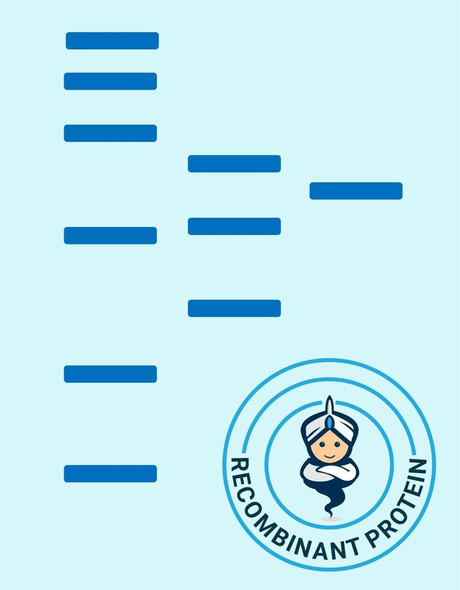Human NFATC2 Recombinant Protein (RPPB4086)
- SKU:
- RPPB4086
- Product type:
- Recombinant Protein
- Size:
- 5ug
- Species:
- Human
- Target:
- NFATC2
- Synonyms:
- Nuclear Factor Of Activated T Cells 2
- Nuclear Factor Of Activated T-Cells
- Cytoplasmic
- Calcineurin-Dependent 2
- Source:
- Sf9 Insect cells
- Uniprot:
- Q13469
Description
| Product Name: | Human NFATC2 Recombinant Protein |
| Product Code: | RPPB4086 |
| Size: | 5µg |
| Species: | Human |
| Target: | NFATC2 |
| Synonyms: | Nuclear Factor Of Activated T Cells 2, Nuclear Factor Of Activated T-Cells, Cytoplasmic, Calcineurin-Dependent 2, Nuclear Factor Of Activated T-Cells 2, NFAT Pre-Existing Subunit, NF-ATc2, NFAT1, NFATP, Nuclear Factor Of Activated T-Cells, Preexisting Component , Nuclear Factor Of Activated T-Cells, Cytoplasmic 2, NFAT Transcription Complex, Preexisting Component, Preexisting Nuclear Factor Of Activated T-Cells 2, T Cell Transcription Factor NFAT1, T-Cell Transcription Factor NFAT1, NF-ATp, NFATc2. |
| Source: | Sf9 Insect cells |
| Physical Appearance: | Sterile Filtered colorless solution. |
| Formulation: | NFATC2 protein solution (0.25mg/ml) contains Phosphate Buffered Saline (pH 7.4) 40% glycerol and 1mM DTT. |
| Stability: | Store at 4°C if entire vial will be used within 2-4 weeks. Store, frozen at -20°C for longer periods of time. For long term storage it is recommended to add a carrier protein (0.1% HSA or BSA). Avoid multiple freeze-thaw cycles. |
| Purity: | Greater than 90.0% as determined by SDS-PAGE. |
| Amino Acid Sequence: | MPLEWPLSSQ SGSYELRIEV QPKPHHRAHY ETEGSRGAVK APTGGHPVVQ LHGYMENKPL GLQIFIGTAD ERILKPHAFY QVHRITGKTV TTTSYEKIVG NTKVLEIPLE PKNNMRATID CAGILKLRNA DIELRKGETD IGRKNTRVRL VFRVHIPESS GRIVSLQTAS NPIECSQRSA HELPMVERQD TDSCLVYGGQ QMILTGQNFT SESKVVFTEK TTDGQQIWEM EATVDKDKSQ PNMLFVEIPE YRNKHIRTPV KVNFYVINGK RKRSQPQHFT YHPVHHHHHH |
NFATC2, also known as nuclear factor of activated T-cells 2, belongs to the nuclear factor of activated T cells family. NFATC2 takes a significant part in the course of T helper cell differentiation, activation, and effector function. Even though KO of an individual NFAT isoform in T cells directs to rather minor effects, T cells lacking for NFATC1 and 2 totally fail to produce T helper cell effector cytokines, for instance the interleukins IL-4 and IL-2. Moreover, NFATC2 is highly phosphorylated and kept in the cytoplasm. Next T cell receptor stimulation, dephosphorylation via calcium-activated calcineurin induces a conformational modification of NFATC2 which reveals a few nuclear localization sequences.
NFATC2 produced in Sf9 Baculovirus cells is a single, glycosylated polypeptide chain containing 290 amino acids (396-678a.a.) and having a molecular mass of 33.1kDa. (Molecular size on SDS-PAGE will appear at approximately 28-40kDa). NFATC2 is expressed with a 7 amino acid His tag at C-Terminus and purified by proprietary chromatographic techniques.
| UniProt Protein Function: | NFAT1: a transcription factor that plays a role in the inducible expression of cytokine genes in T cells, especially in the induction of the IL-2, IL-3, IL-4, TNF-alpha and GM-CSF. It is present in a phosphorylated the cytosol of unstimulated T cells. After T-cell activation, it is dephosphorylated by calcineurin and translocates to the nucleus as a part of a transcription complex. Two splice variant isoforms have been identified. |
| UniProt Protein Details: | Protein type:DNA-binding; Transcription factor Chromosomal Location of Human Ortholog: 20q13.2 Cellular Component: nucleoplasm; cytoplasm; plasma membrane; ribonucleoprotein complex; nucleus; cytosol; actin cytoskeleton Molecular Function:protein binding; DNA binding; transcription factor activity Biological Process: response to drug; B cell receptor signaling pathway; cell migration; transcription, DNA-dependent; regulation of transcription, DNA-dependent; positive regulation of transcription, DNA-dependent; positive regulation of B cell proliferation; cytokine production; innate immune response; positive regulation of transcription from RNA polymerase II promoter; negative regulation of transcription from RNA polymerase II promoter; response to DNA damage stimulus |
| NCBI Summary: | This gene is a member of the nuclear factor of activated T cells (NFAT) family. The product of this gene is a DNA-binding protein with a REL-homology region (RHR) and an NFAT-homology region (NHR). This protein is present in the cytosol and only translocates to the nucleus upon T cell receptor (TCR) stimulation, where it becomes a member of the nuclear factors of activated T cells transcription complex. This complex plays a central role in inducing gene transcription during the immune response. Alternate transcriptional splice variants encoding different isoforms have been characterized. [provided by RefSeq, Apr 2012] |
| UniProt Code: | Q13469 |
| NCBI GenInfo Identifier: | 68846905 |
| NCBI Gene ID: | 4773 |
| NCBI Accession: | Q13469.2 |
| UniProt Secondary Accession: | Q13469,Q13468, Q5TFW7, Q5TFW8, Q9NPX6, Q9NQH3, Q9UJR2 B5B2N8, B5B2N9, B5B2P0, B5B2P2, B5B2P3, |
| UniProt Related Accession: | Q13469 |
| Molecular Weight: | 901 |
| NCBI Full Name: | Nuclear factor of activated T-cells, cytoplasmic 2 |
| NCBI Synonym Full Names: | nuclear factor of activated T-cells, cytoplasmic, calcineurin-dependent 2 |
| NCBI Official Symbol: | NFATC2 |
| NCBI Official Synonym Symbols: | NFAT1; NFATP |
| NCBI Protein Information: | nuclear factor of activated T-cells, cytoplasmic 2; NF-ATc2; NFAT pre-existing subunit; T cell transcription factor NFAT1; T-cell transcription factor NFAT1; NFAT transcription complex, preexisting component; preexisting nuclear factor of activated T-cells 2; nuclear factor of activated T-cells, preexisting component |
| UniProt Protein Name: | Nuclear factor of activated T-cells, cytoplasmic 2 |
| UniProt Synonym Protein Names: | NFAT pre-existing subunit; NF-ATp; T-cell transcription factor NFAT1 |
| Protein Family: | NFATC2-interacting protein |
| UniProt Gene Name: | NFATC2 |
| UniProt Entry Name: | NFAC2_HUMAN |









